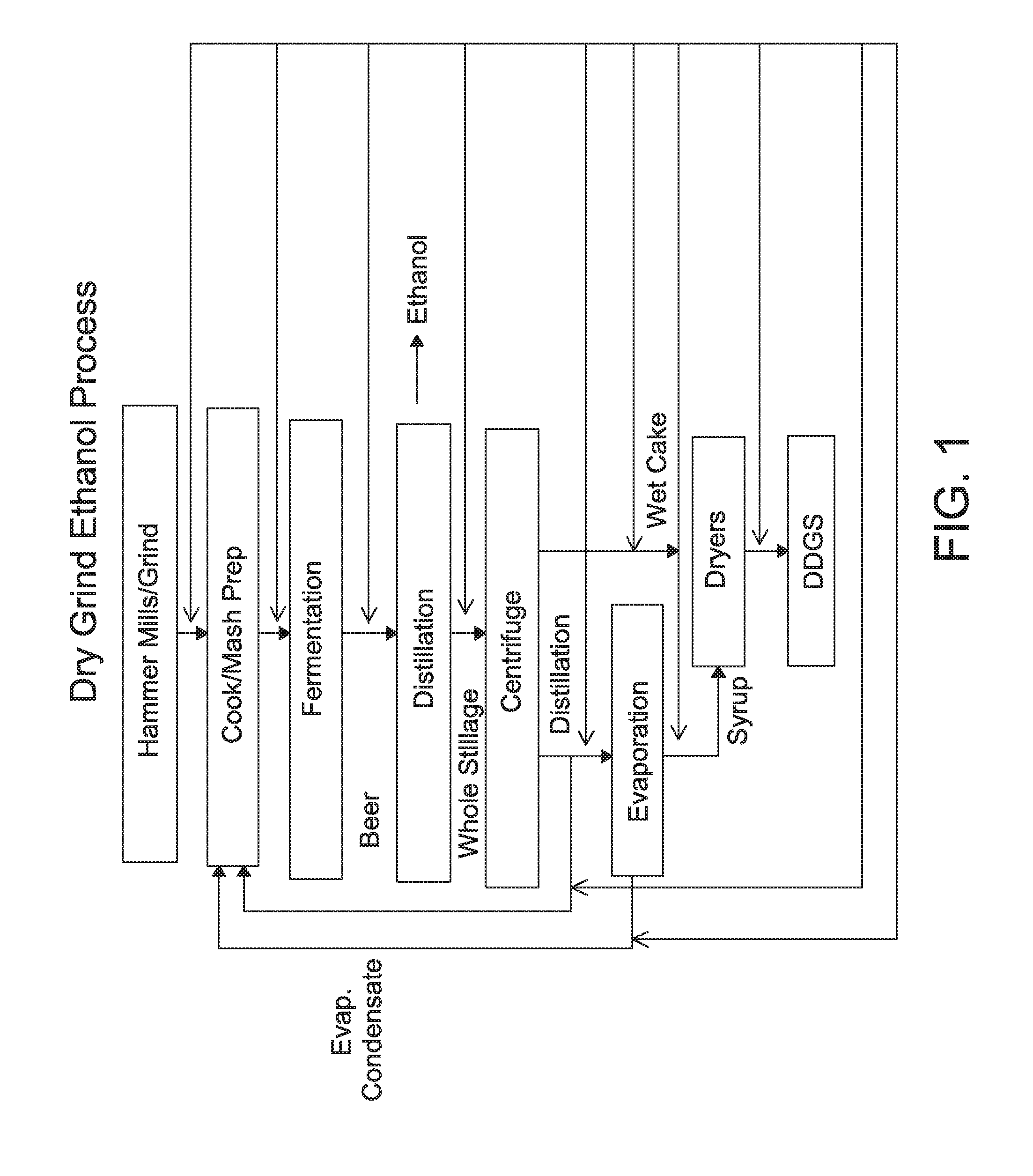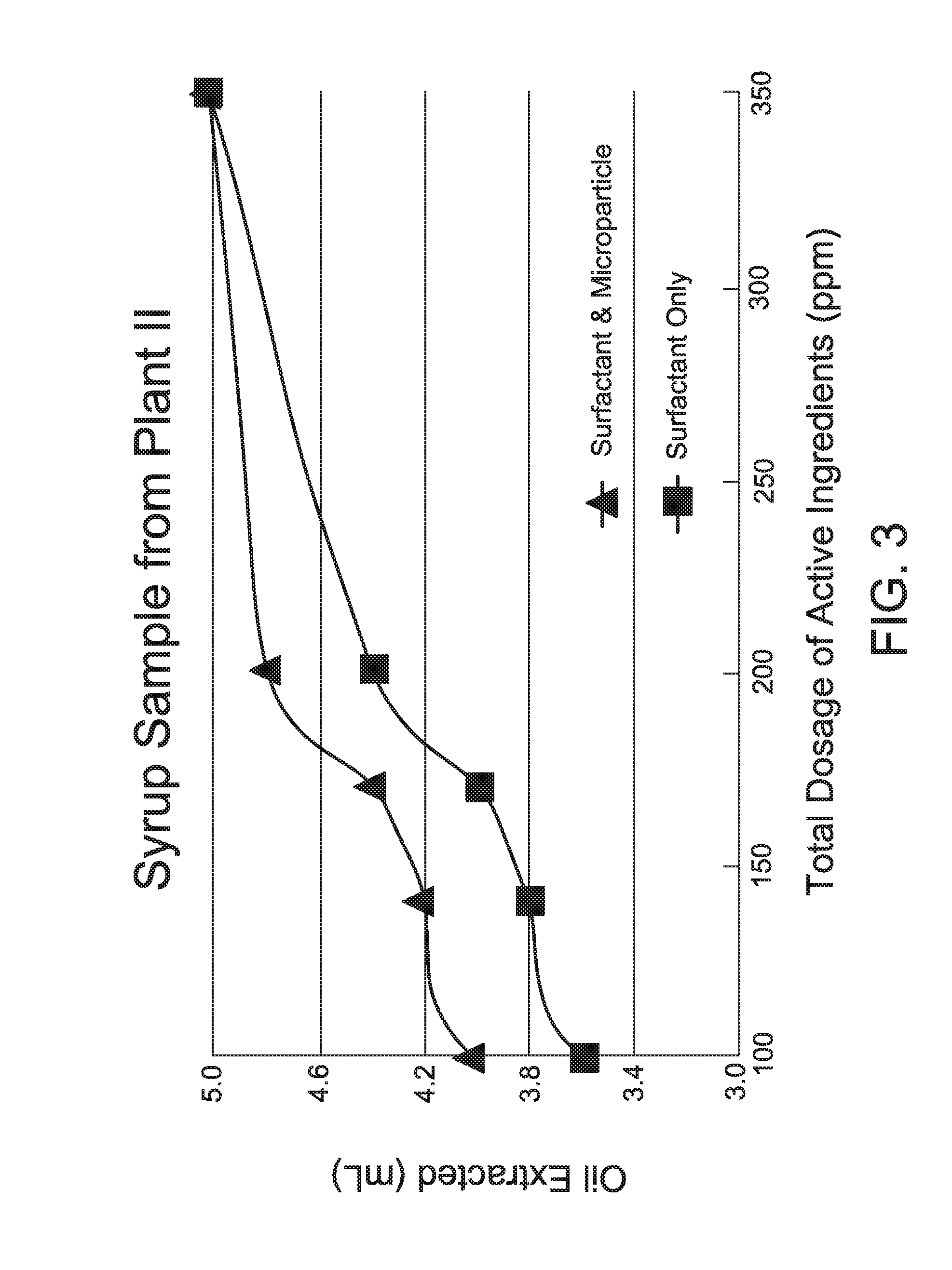Chemical Additives to Improve Oil Separation in Stillage Process Operations
- Summary
- Abstract
- Description
- Claims
- Application Information
AI Technical Summary
Benefits of technology
Problems solved by technology
Method used
Image
Examples
example 1
[0099]This Example illustrates the amount of oil extracted from thick stillage in the presence of a surfactant and microparticle in accordance with an embodiment of the invention.
[0100]Thick stillage was obtained from a dry grind corn to ethanol manufacturing plant (“Plant I”). Samples of the thick stillage were treated with Tween 80 polysorbate surfactant (available as GR8109 from Nalco Company, Naperville, Ill.) alone at various dosages. Samples of the thick stillage were also treated with Tween 80 polysorbate surfactant and hydrophilic colloidal silica microparticle (available as POSITEK N9000 from Nalco Company, Naperville, Ill.) at various dosages. The surfactant and silica microparticle were dosed at a weight ratio of 5.25:1 (surfactant: silica microparticle).
[0101]For each sample, the thick stillage was heated to about 189° F., then the surfactant and the microparticle (when applicable) were added at the indicated dosage under mixing. The mixture was mixed for about 10 minute...
example 2
[0105]This Example illustrates the amount of oil extracted from thick stillage in the presence of a surfactant and microparticle for various stillage samples in accordance with an embodiment of the invention.
[0106]A variety of thick stillage samples were obtained from a dry grind corn to ethanol manufacturing plant. Syrup sample I had a solids content of 17% by weight and was obtained from an Illinois corn crop greater than six months old. Syrup sample II had a solids content of 17% by weight and was obtained from an Illinois corn crop less than six months old. Syrup sample III had a solids content of 31% by weight and was obtained from an Illinois corn crop less than six months old. Syrup sample IV had a solids content of 28% by weight and was obtained from a Nebraska corn crop less than six months old. Syrup sample V had a solids content of 30% by weight and was obtained from a South Dakota corn crop less than six months old. The samples were treated with both Tween 80 and colloid...
example 3
[0108]This Example illustrates the amount of oil extracted from thick stillage in the presence of a surfactant and various microparticles in accordance with an embodiment of the invention.
[0109]Thick stillage samples were obtained from a dry grind corn to ethanol manufacturing plant. The samples were treated with Tween 80 surfactant and colloidal, precipitated, or fumed silica (available from Evonik). The polysorbate surfactant and silica microparticle were used at a weight ratio of 5.25:1 (surfactant: silica microparticle). Oil extraction for each sample was performed in the same manner as described in Example 1.
[0110]The amount of oil extracted from each sample is shown in FIG. 6. The data demonstrates that the use of colloidal, fumed, and precipitated silica and surfactant produced greater amounts of oil from the thick stillage than surfactant alone. Furthermore, the data shows that colloidal silica is particularly effective at increasing oil extraction.
PUM
 Login to View More
Login to View More Abstract
Description
Claims
Application Information
 Login to View More
Login to View More - R&D
- Intellectual Property
- Life Sciences
- Materials
- Tech Scout
- Unparalleled Data Quality
- Higher Quality Content
- 60% Fewer Hallucinations
Browse by: Latest US Patents, China's latest patents, Technical Efficacy Thesaurus, Application Domain, Technology Topic, Popular Technical Reports.
© 2025 PatSnap. All rights reserved.Legal|Privacy policy|Modern Slavery Act Transparency Statement|Sitemap|About US| Contact US: help@patsnap.com



